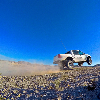Brock94
Well-Known Member
- Joined
- July 2, 2004
- Messages
- 553
- Reaction score
- 3
- City, State
- Milford, CT
- Year, Model & Trim Level
- 1994 XLT
[For the short version, skip to the third paragraph.]
Well, the X left me on the side of the road for the first time last Friday. The brake pedal got really soft and unresponsive, so I pulled over and called a tow truck. When I opened the hood, the brake fluid was almost gone from the reservior-- it looked like the front part of the reservior may have been empty, but I'm not sure. The rear part still had a little fluid in it.
When I got the truck home, I refilled the reservior, just to avoid the need to bleed the master cylinder and ABS stuff assuming there wasn't air in there already.
So obviously the brake lines are leaking... the next day, I noticed a small puddle under the gas tank. It appears that the brake line that goes along the frame rail next to the fuel tank is leaking. So now I need to learn how to replace brake lines. The rubber hoses aren't in the best shape either, so I might as well replace them too.
Well, as I get ready to do this, I wanted to see if you had any advice... Are the flaring tools pretty easy to use? Do I need a tubing bender? Any recommendations?
Are aftermarket parts available/good or should I go with OEM from the dealer? Are the fittings standardized or do I need to bring in the old ones to get a match? Any advice as to techniques or likely problems? Is it likely that I did any damage to my master cylinder if it ran dry? (other than getting air in it)
Any and all thoughts coming from your experience are welcome!
Well, the X left me on the side of the road for the first time last Friday. The brake pedal got really soft and unresponsive, so I pulled over and called a tow truck. When I opened the hood, the brake fluid was almost gone from the reservior-- it looked like the front part of the reservior may have been empty, but I'm not sure. The rear part still had a little fluid in it.
When I got the truck home, I refilled the reservior, just to avoid the need to bleed the master cylinder and ABS stuff assuming there wasn't air in there already.
So obviously the brake lines are leaking... the next day, I noticed a small puddle under the gas tank. It appears that the brake line that goes along the frame rail next to the fuel tank is leaking. So now I need to learn how to replace brake lines. The rubber hoses aren't in the best shape either, so I might as well replace them too.
Well, as I get ready to do this, I wanted to see if you had any advice... Are the flaring tools pretty easy to use? Do I need a tubing bender? Any recommendations?
Are aftermarket parts available/good or should I go with OEM from the dealer? Are the fittings standardized or do I need to bring in the old ones to get a match? Any advice as to techniques or likely problems? Is it likely that I did any damage to my master cylinder if it ran dry? (other than getting air in it)
Any and all thoughts coming from your experience are welcome!










